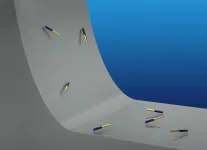Scientists find way to navigate a heavy uphill climb
Tiny motors behave like rock climbers
2021-07-14
(Press-News.org) A team of scientists has uncovered how heavy, motorized objects climb steep slopes--a newly discovered mechanism that also mimics how rock climbers navigate inclines.
The findings, which appear in the journal Soft Matter, stem from a series of experiments in which motorized objects were placed in liquid and then moved up tilted surfaces.
"These 'micro-swimmers' are about 20 times heavier than the fluid they swim in, but they were able to climb steep slopes that are almost vertical," explains Jun Zhang, one of the paper's authors and a professor of physics and mathematics at New York University's Courant Institute of Mathematical Sciences and NYU Shanghai.
The work enhances our understanding of "gravitaxis"--directional movement in response to gravity. The phenomenon is a vital consideration in not only engineering, but also in medicine and pharmaceutical development. It explains, in part, how bacteria move through the body and provides insights into ways to create more effective drug-delivery mechanisms.
In the Soft Matter research, the scientists created swimmers, or nanorods, whose length is roughly 1/40th the width of a strand of human hair. These motorized swimmers were tasked with moving up an inclined surface while immersed in a liquid solution within a walled container. The swimmers were composed of two types of metal--gold and rhodium as well as gold and platinum--a makeup that gave them unbalanced densities given the varying weights of these metals.
The swimmers' composition, liquid environment, and juxtaposition of surfaces enabled them to move upward, despite their significant weight.
"These motors reorient themselves upward against gravity thanks to their density imbalance--much like a seesaw reorients itself in response to the movement and weight of its riders," adds Michael Shelley, a professor at the Courant Institute and director of the Flatiron Institute's Center for Computational Biology. "A hydrodynamic effect amplifies this movement--swimming next to a wall yields a bigger torque in repositioning the motors' bodies upwards. This is important because the microscopic world is noisy--for the motor it's always two steps up and one step down--and the bigger torque improves their ability to move vertically."
In previous work, published in Physical Review Letters, Zhang, Shelley, and their colleagues created "nano-motors" in uncovering an effective means of movement against currents. The new research expands on these findings by revealing how heavy objects can move up steeply inclined surfaces, offering the promise of even more sophisticated maneuvers.
"Now that these micro-swimmers are able to climb very steep slopes against gravity, we can look toward developing even more difficult assignments," observes Zhang. "Future, advanced motors will be designed to reach targeted locations and to perform designated functions."
INFORMATION:
The study's other co-authors included Quentin Brosseau, a post-doctoral researcher at the Courant Institute at the time of the research, Yang Wu, a doctoral candidate in NYU's Department of Chemistry, Michael Ward, a professor in NYU's Department of Chemistry, Leif Ristroph, an associate professor at the Courant Institute, Florencio Balboa Usabiaga of the Flatiron Institute, and Enkeleida Lushi of the New Jersey Institute of Technology.
This work was supported by the MRSEC Program of the National Science Foundation (DMR-1420073) and also by NSF grants DMS-RTG-1646339, DMS-1463962, and DMS- 1620331.
[Attachments] See images for this press release:

ELSE PRESS RELEASES FROM THIS DATE:
2021-07-14
The physical interactions between coral and algal cells as they combine to form a symbiotic relationship have been observed for the first time. Within minutes of being introduced, coral cells had started to engulf the algae, where they were either digested or moved to a protective 'bubble' within the cell. This new study, published in Frontiers in Marine Science, will form the basis of further research to understand what drives their symbiosis at a cellular and molecular level, including the eviction of algae, which is the cause of coral bleaching.
"We watched coral cells develop pseudopodia ...
2021-07-14
Depression is the most frequently diagnosed psychiatric disorder among older adults, with 8% to 16% of older patients presenting with clinically significant depressive symptoms. Researchers in Spain conducted a randomized clinical trial of 347 older adults with mild to moderate depression, comparing the effectiveness of physical exercise and antidepressants as treatment methods. Study participants were assigned to either a group engaged in supervised physical exercise or a group that received antidepressant treatment by their general practitioners. Depressive symptoms were not significantly different after one month between the two groups. However, after three and six months, the number of people who showed improvement was significantly higher in the ...
2021-07-14
WASHINGTON--People with diabetes and depression who take antidepressants may have a lower risk of death and of serious diabetes complications, according to a new study published in the Endocrine Society's Journal of Clinical Endocrinology & Metabolism.
People with diabetes face a higher risk of depression, which makes them more likely to die or develop diabetes complications including heart and kidney disease, stroke, eye, and foot problems. Depression makes diabetes complications worse due to stress, body weight changes, and lack of exercise.
"People with depression and diabetes have poorer health outcomes than those with diabetes alone, and regular antidepressant treatment could lower their risk of complications," said study author Shi-Heng Wang, Ph.D., of the China Medical ...
2021-07-14
Researchers at Johns Hopkins Bloomberg School of Public Health have shown in a brain organoid study that exposure to a common pesticide synergizes with a frequent autism-linked gene mutation.
The results represent one of the clearest pieces of evidence yet that genetic and environmental factors may be able to combine to disturb neurodevelopment. Researchers suspect that genetic and environmental factors might contribute to the increased prevalence of autism spectrum disorder, a developmental disorder characterized by cognitive function, social, and communication impairments.
The study's use of brain organoids also points the way towards quicker, less expensive, and more human-relevant ...
2021-07-14
Forest fires are already a global threat. "But considering how climate change is progressing, we are probably only at the beginning of a future that will see more and bigger forest fires," explains Rupert Seidl, Professor of Ecosystem Dynamics and Forest Management in Mountain Landscapes at TUM.
In many places, fire is part of the natural environment, and many tree species have become naturally adapted to recurrent fires. These adaptations range from particularly thick bark, which protects the sensitive cambium in the trunk from the fire, to the cones of certain types of pine, which open only due to the heat of fire, allowing a quick regeneration and recovery of affected woodland .
AI is accelerating ecosystem models
"The interaction ...
2021-07-14
Skoltech researchers and their colleagues from the U.S. and Singapore have created a neural network that can help tweak semiconductor crystals in a controlled fashion to achieve superior properties for electronics. This enables a new direction of development of next-generation chips and solar cells by exploiting a controllable deformation that may change the properties of a material on the fly. The paper was published in the journal npj Computational Materials.
Materials at the nanoscale can withstand major deformation. In what's called the strained state, they can exhibit remarkable optical, thermal, electronic, and other properties due to a change in interatomic distances. The intrinsic properties of a strained ...
2021-07-14
Researchers examined the role of primary care physicians and other clinicians in delivering vaccinations in the United States. They used two main datasets to create an in-depth analysis of services delivered to Medicare patients, followed by analysis of the Agency for Healthcare Research and Quality's 2017 Medical Expenditure Panel Survey (MEPS) to determine where patients are getting vaccinated and by whom. In the 2017 Medicare Part B Fee-For-Service, primary care physicians provided the largest share of services for vaccinations (46%), followed by mass immunizers (45%), then nurse practitioners/physician assistants (5%). The MEPS showed that primary care physicians provided a majority of clinical visits ...
2021-07-14
Primary Care Poised to Provide Clinical Guidance, Answers About COVID-19 Testing, Vaccine Administration
Researchers examined the role of primary care physicians and other clinicians in delivering vaccinations in the United States. They used two main datasets to create an in-depth analysis of services delivered to Medicare patients, followed by analysis of the Agency for Healthcare Research and Quality's 2017 Medical Expenditure Panel Survey (MEPS) to determine where patients are getting vaccinated and by whom. In the 2017 Medicare Part B Fee-For-Service, primary care physicians provided the largest share of services for vaccinations (46%), followed by mass immunizers (45%), then nurse practitioners/physician ...
2021-07-14
Humans are no stranger to coronavirus (CoV) pandemics. Just like SARS-CoV-2 (the virus that causes COVID-19), another member of the coronavirus family--SARS-CoV--caused the severe acute respiratory syndrome (SARS) epidemic across parts of Asia in 2003. But, its spread was contained way faster than COVID-19. So, what makes SARS-CoV-2 so contagious?
Both SARS-CoV and SARS-CoV-2 viruses bear "spike proteins" which get inside our cells by binding to a protein called angiotensin-converting enzyme 2 (ACE2) that is found in our cells. However, the SARS-CoV-2 spike (S) protein has been found to have a higher binding affinity (10 to 20 times that of SARS-CoV) to ACE2, thus establishing ...
2021-07-14
An international research team, including physics from Russia, has created new glasses for protection against X-ray and gamma radiation. Scientists could select new components that improved the characteristics of the samples and allowed to reduce the amount of lead in the glass composition. Physicists engineered several samples of glasses. One of the latest results - glasses based on barium fluoride - was described by the team in the Optic magazine. But the best results have bismuth borate glasses. Its radiation protection characteristics (mean-free-path, half-value layer) are better than commercial ...
LAST 30 PRESS RELEASES:
[Press-News.org] Scientists find way to navigate a heavy uphill climb
Tiny motors behave like rock climbers



